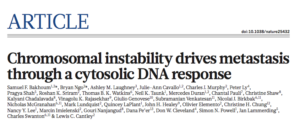Can STING (stimulator of interferon genes) agonists promote cancer metastasis in some patients?
That’s the intriguing question posed by research published recently in the journal Nature by Dr Samuel Bakhoum @Samuel_Bakhoum and colleagues. (doi:10.1038/nature25432) who found that, “chromosomal unstable tumour cells co-opt chronic activation of innate immune pathways to spread to distant organs.”
Samuel F. Bakhoum, MD PhD is a Holman research fellow at Weill Cornell Medicine and a senior resident in radiation oncology at Memorial Sloan Kettering Cancer Center in New York. The joint first author of the Nature article is Bryan Ngo, a student in the Weill Cornell Graduate School of Medical Sciences. It’s impressive work from two early career researchers.
The paper raises several important questions that drug developers – several of whom already have STING agonists in the clinic – may need to carefully think about. It is, however, important to point out that this data is preclinical, so we don’t yet know what may or may not happen in cancer patients.
We first heard about the data published in Bakhoum, Ngo et al’s Nature article, “Chromosomal instability drives metastasis through a cytosolic DNA response,” at last October’s excellent AACR-NCI-EORTC Molecular Targets and Cancer Therapeutics meeting in Philadelphia.

What we learnt at #Targets17 was that chromosomal instability is linked to tumour metastasis through the STING pathway.
Readers of BSB will know that we’ve been covering activation of innate immunity through the STING pathway for several years now (See posts: “What we learnt at AACR about Aduro ADU-S100” and “Tom Gajewski takes the STING out of Cancer,” to name but a few.
So how do we reconcile the positive and encouraging data that has led to development of multiple STING agonists, several of which are now in the clinic, with the potential that there might be a harmful aspect to them?
There are some important subtleties and nuances around this critical issue and that is the essence of this post and what we sought to gain more insight into, beyond the obvious superficial answer that there could be harmful effects involved.
The Roman god Janus is depicted as having two faces – one looking to the future and the other to the past.
There are also two faces to cancer immunotherapy: It can be a force for good, we can harness our immune system in a way that results in a positive outcome – people with cancer live longer, some are even cured. Alternatively, if we harness the immune system in a negative way it can also be a force for harm.
We heard on the recent Novel Targets Podcast episode that while combination cancer immunotherapies can be effective in a subset of people, they can also lead to rip-roaring toxicities as well as unwanted auto-immune side effects, and in some cases, these can be fatal. With multiple inhibitory and activating forces at place, cancer immunotherapy can tread a fine line balancing these out.
Dr Bakhoum kindly spoke to BSB about the translational and clinical implications of this latest research.
Given the potential impact of this research, we also sought additional commentary from experts active in STING research such as Jason Luke, MD FACP (@JasonLukeMD). He’s an Assistant Professor in the Department of Medicine at the University of Chicago and a Principal Investigator for early immunotherapy trials, including those with STING agonists.
BSB readers may recall we did an in-depth interview with him at AACR17 (See post: Overcoming Immunotherapy Resistance). This time around, he shared his perspective on Dr Bakhoum’s research and looked at the potential clinical implications.
Like Janus, does the STING pathway really have two faces to it?
Should companies with STING agonists be concerned or not?
To learn more and get a heads up on our latest thought leader interview, subscribers can log-in or you can click to gain access to BSB Premium Content.
This content is restricted to subscribers
 Last week we reported on a paper published in Nature by Bakhoum et al that raised the provocative question, Can STING agonists promote metastasis? (Link to BSB post).
Last week we reported on a paper published in Nature by Bakhoum et al that raised the provocative question, Can STING agonists promote metastasis? (Link to BSB post). In this latest post, we continue the story with a perspective on this research from one of the world’s leading experts on the science behind the STING (stimulator of Interferon genes) pathway.
In this latest post, we continue the story with a perspective on this research from one of the world’s leading experts on the science behind the STING (stimulator of Interferon genes) pathway.


 In the sixth Preview relating to the annual meeting at #AACR17, we take a closer look at an immuno-oncology topic that we are likely to see and hear more about over the next couple of years.
In the sixth Preview relating to the annual meeting at #AACR17, we take a closer look at an immuno-oncology topic that we are likely to see and hear more about over the next couple of years.